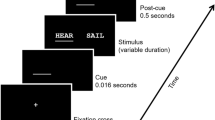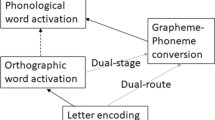Abstract
Two different forms of parafoveal dysfunction have been hypothesized as core deficits of dyslexic individuals: reduced parafoveal preview benefits (“too little parafovea”) and increased costs of parafoveal load (“too much parafovea”). We tested both hypotheses in a single eye-tracking experiment using a modified serial rapid automatized naming (RAN) task. Comparisons between dyslexic and non-dyslexic adults showed reduced parafoveal preview benefits in dyslexics, without increased costs of parafoveal load. Reduced parafoveal preview benefits were observed in a naming task, but not in a silent letter-finding task, indicating that the parafoveal dysfunction may be consequent to the overload with extracting phonological information from orthographic input. Our results suggest that dyslexics’ parafoveal dysfunction is not based on strict visuo-attentional factors, but nevertheless they stress the importance of extra-phonological processing. Furthermore, evidence of reduced parafoveal preview benefits in dyslexia may help understand why serial RAN is an important reading predictor in adulthood.



Similar content being viewed by others
References
Barreto, H., Moreira, A., & Ferreira, C. (2008). Wechsler Adult Intelligence Scale (WAIS-III): Versão Portuguesa [WAIS-III: Portuguese version]. Lisboa: Cegoc.
Bellocchi, S., Muneaux, M., Bastien-Toniazzo, M., & Ducrot, S. (2013). I can read it in your eyes: what eye movements tell us about visuo-attentional processes in developmental dyslexia. Research in Developmental Disabilities, 34(1), 452–460. doi:10.1016/j.ridd.2012.09.002.
Blomert, L., & Vaessen, A. (2009). 3DM differential diagnostics for dyslexia: cognitive analysis of reading and spelling. Amsterdam: Boom Test.
Bosse, M.-L., Tainturier, M. J., & Valdois, S. (2007). Developmental dyslexia: the visual attention span deficit hypothesis. Cognition, 104(2), 198–230. doi:10.1016/j.cognition.2006.05.009.
Bouma, H. (1973). Visual interference in the parafoveal recognition of initial and final letters of words. Vision Research, 13(4), 767–782. doi:10.1016/0042-6989(73)90041-2.
Bouma, H., & Legein, C. P. (1977). Foveal and parafoveal recognition of letters and words by dyslexics and by average readers. Neuropsychologia, 15(1), 69–80. doi:10.1016/0028-3932(77)90116-6.
Callens, M., Whitney, C., Tops, W., & Brysbaert, M. (2013). No deficiency in left-to-right processing of words in dyslexia but evidence for enhanced visual crowding. The Quarterly Journal of Experimental Psychology, 66(9), 1803–1817. doi:10.1080/17470218.2013.766898.
Castro, S. L., & Alves, R. A. (2005). Despistagem da dislexia em adultos através do Questionário de História de Leitura. Iberpsicología: Revista Electrónica de la Federación española de Asociaciones de Psicología, 10(8), 9–. Accessed 11 Mar 2015.
Chace, K. H., Rayner, K., & Well, A. D. (2005). Eye movements and phonological parafoveal preview: effects of reading skill. Canadian Journal of Experimental Psychology/Revue Canadienne de Psychologie Expérimentale, 59(3), 209–217. doi:10.1037/h0087476.
De Luca, M., Di Pace, E., Judica, A., Spinelli, D., & Zoccolotti, P. (1999). Eye movement patterns in linguistic and non-linguistic tasks in developmental surface dyslexia. Neuropsychologia, 37(12), 1407–1420. doi:10.1016/S0028-3932(99)00038-X.
Denckla, M. B., & Rudel, R. G. (1976). Rapid “automatized” naming (R.A.N.): dyslexia differentiated from other learning disabilities. Neuropsychologia, 14(4), 471–479. doi:10.1016/0028-3932(76)90075-0.
Di Filippo, G., Brizzolara, D., Chilosi, A., De Luca, M., Judica, A., Pecini, C., et al. (2005). Rapid naming, not cancellation speed or articulation rate, predicts reading in an orthographically regular language (Italian). Child Neuropsychology, 11(4), 349–361. doi:10.1080/09297040490916947.
Di Filippo, G., Brizzolara, D., Chilosi, A., De Luca, M., Judica, A., Pecini, C., et al. (2006). Naming speed and visual search deficits in readers with disabilities: evidence from an orthographically regular language (Italian). Developmental Neuropsychology, 30(3), 885–904. doi:10.1207/s15326942dn3003_7.
Fernandes, T., Araújo, S., Sucena, A., Reis, A., & Castro, S. L. (2014). The 1-min screening test for reading problems in college students: psychometric properties and dyslexic readers profile. Submitted.
Georgiou, G. K., Parrila, R., Cui, Y., & Papadopoulos, T. C. (2013). Why is rapid automatized naming related to reading? Journal of Experimental Child Psychology, 115(1), 218–225. doi:10.1016/j.jecp.2012.10.015.
Germano, G. D., Reilhac, C., Capellini, S. A., & Valdois, S. (2014). The phonological and visual basis of developmental dyslexia in Brazilian Portuguese reading children. Frontiers in Psychology, 5. doi:10.3389/fpsyg.2014.01169.
Hawelka, S., & Wimmer, H. (2005). Impaired visual processing of multi-element arrays is associated with increased number of eye movements in dyslexic reading. Vision Research, 45(7), 855–863. doi:10.1016/j.visres.2004.10.007.
Hawelka, S., & Wimmer, H. (2008). Visual target detection is not impaired in dyslexic readers. Vision Research, 48(6), 850–852. doi:10.1016/j.visres.2007.11.003.
Henderson, J. M., & Ferreira, F. (1990). Effects of foveal processing difficulty on the perceptual span in reading: implications for attention and eye movement control. Journal of Experimental Psychology: Learning, Memory, and Cognition, 16(3), 417–429. doi:10.1037/0278-7393.16.3.417.
Jones, M. W., Kelly, M. L., & Corley, M. (2007). Adult dyslexic readers do not demonstrate regularity effects in sentence processing: evidence from eye-movements. Reading and Writing, 20(9), 933–943. doi:10.1007/s11145-007-9060-3.
Jones, M. W., Obregón, M., Louise Kelly, M., & Branigan, H. P. (2008). Elucidating the component processes involved in dyslexic and non-dyslexic reading fluency: an eye-tracking study. Cognition, 109(3), 389–407. doi:10.1016/j.cognition.2008.10.005.
Jones, M. W., Branigan, H. P., & Kelly, M. L. (2009). Dyslexic and nondyslexic reading fluency: rapid automatized naming and the importance of continuous lists. Psychonomic Bulletin & Review, 16(3), 567–572. doi:10.3758/PBR.16.3.567.
Lassus-Sangosse, D., N’guyen-Morel, M.-A., & Valdois, S. (2008). Sequential or simultaneous visual processing deficit in developmental dyslexia? Vision Research, 48(8), 979–988. doi:10.1016/j.visres.2008.01.025.
Lewandowska, M., Milner, R., Ganc, M., Włodarczyk, E., & Skarżyński, H. (2014). Attention dysfunction subtypes of developmental dyslexia. Medical Science Monitor: International Medical Journal of Experimental and Clinical Research, 20, 2256–2268. doi:10.12659/MSM.890969.
Martelli, M., Di Filippo, G., Spinelli, D., & Zoccolotti, P. (2009). Crowding, reading, and developmental dyslexia. Journal of Vision, 9(4), 14. doi:10.1167/9.4.14.
McConkie, G. W., & Rayner, K. (1975). The span of the effective stimulus during a fixation in reading. Perception & Psychophysics, 17(6), 578–586. doi:10.3758/BF03203972.
Moll, K., & Jones, M. (2013). Naming fluency in dyslexic and nondyslexic readers: differential effects of visual crowding in foveal, parafoveal, and peripheral vision. The Quarterly Journal of Experimental Psychology, 66(11), 2085–2091. doi:10.1080/17470218.2013.840852.
Moores, E., Cassim, R., & Talcott, J. B. (2011). Adults with dyslexia exhibit large effects of crowding, increased dependence on cues, and detrimental effects of distractors in visual search tasks. Neuropsychologia, 49(14), 3881–3890. doi:10.1016/j.neuropsychologia.2011.10.005.
Nergård-Nilssen, T., & Hulme, C. (2014). Developmental dyslexia in adults: behavioural manifestations and cognitive correlates. Dyslexia, 20(3), 191–207. doi:10.1002/dys.1477.
Norton, E. S., & Wolf, M. (2012). Rapid automatized naming (RAN) and reading fluency: implications for understanding and treatment of reading disabilities. Annual Review of Psychology, 63, 427–452. doi:10.1146/annurev-psych-120710-100431.
Pavlidis, G. T. (1981). Do eye movements hold the key to dyslexia? Neuropsychologia, 19(1), 57–64.
Perea, M., Panadero, V., Moret-Tatay, C., & Gómez, P. (2012). The effects of inter-letter spacing in visual-word recognition: evidence with young normal readers and developmental dyslexics. Learning and Instruction, 22(6), 420–430. doi:10.1016/j.learninstruc.2012.04.001.
Pernet, C., Valdois, S., Celsis, P., & Démonet, J.-F. (2006). Lateral masking, levels of processing and stimulus category: a comparative study between normal and dyslexic readers. Neuropsychologia, 44(12), 2374–2385. doi:10.1016/j.neuropsychologia.2006.05.003.
Pollatsek, A., Reichle, E. D., & Rayner, K. (2006). Tests of the E-Z Reader model: exploring the interface between cognition and eye-movement control. Cognitive Psychology, 52(1), 1–56. doi:10.1016/j.cogpsych.2005.06.001.
Rayner, K., Murphy, L. A., Henderson, J. M., & Pollatsek, A. (1989). Selective attentional dyslexia. Cognitive Neuropsychology, 6(4), 357–378. doi:10.1080/02643298908253288.
Reichle, E. D., Rayner, K., & Pollatsek, A. (2003). The E-Z reader model of eye-movement control in reading: comparisons to other models. The Behavioral and Brain Sciences, 26(4), 445–476. discussion 477–526.
Reis, A., Faísca, L., Castro, S., Inácio, F., Pacheco, A., Araújo, S., & Santos, M. (2014). Versão Portuguesa da Bateria 3DM para avaliação da leitura e da escrita [3DM Portuguese version to assess reading and spelling skills]. Manuscript in preparation.
Schotter, E. R., Angele, B., & Rayner, K. (2012). Parafoveal processing in reading. Attention, Perception, & Psychophysics, 74(1), 5–35. doi:10.3758/s13414-011-0219-2.
Sperlich, A., Schad, D. J., & Laubrock, J. (2015). When preview information starts to matter: development of the perceptual span in German beginning readers. Journal of Cognitive Psychology, 5, 1–20. doi:10.1080/20445911.2014.993990.
Spinelli, D., De Luca, M., Judica, A., & Zoccolotti, P. (2002). Crowding effects on word identification in developmental dyslexia. Cortex, 38(2), 179–200. doi:10.1016/S0010-9452(08)70649-X.
Sucena, A., & Castro, S. L. (2010). Aprender a ler e avaliar a leitura. O TIL: Teste de Idade de Leitura. Coimbra: Almedina.
Valdois, S., Bosse, M.-L., & Tainturier, M.-J. (2004). The cognitive deficits responsible for developmental dyslexia: review of evidence for a selective visual attentional disorder. Dyslexia (Chichester, England), 10(4), 339–363. doi:10.1002/dys.284.
Wechsler, D. (1997). WAIS-III, wechsler adult intelligence scale: administration and scoring manual. Psychological Corporation.
Wimmer, H., Mayringer, H., & Landerl, K. (1998). Poor reading: a deficit in skill-automatization or a phonological deficit? Scientific Studies of Reading, 2(4), 321–340. doi:10.1207/s1532799xssr0204_2.
Wolf, M., & Bowers, P. G. (1999). The double-deficit hypothesis for the developmental dyslexias. Journal of Educational Psychology, 91(3), 415–438. doi:10.1037/0022-0663.91.3.415.
Yan, M., Pan, J., Laubrock, J., Kliegl, R., & Shu, H. (2013). Parafoveal processing efficiency in rapid automatized naming: a comparison between Chinese normal and dyslexic children. Journal of Experimental Child Psychology, 115(3), 579–589. doi:10.1016/j.jecp.2013.01.007.
Ziegler, J. C., Pech-Georgel, C., Dufau, S., & Grainger, J. (2010). Rapid processing of letters, digits and symbols: what purely visual-attentional deficit in developmental dyslexia? Developmental Science, 13(4), F8–F14. doi:10.1111/j.1467-7687.2010.00983.x.
Zoccolotti, P., De Luca, M., Lami, L., Pizzoli, C., Pontillo, M., & Spinelli, D. (2013). Multiple stimulus presentation yields larger deficits in children with developmental dyslexia: a study with reading and RAN-type tasks. Child Neuropsychology, 19(6), 639–647. doi:10.1080/09297049.2012.718325.
Zorzi, M., Barbiero, C., Facoetti, A., Lonciari, I., Carrozzi, M., Montico, M., et al. (2012). Extra-large letter spacing improves reading in dyslexia. Proceedings of the National Academy of Sciences, 109(28), 11455–11459. doi:10.1073/pnas.1205566109.
Acknowledgments
This work was supported by Fundação para a Ciência e a Tecnologia under grants PTDC/PSI-PCO/110734/2009, SFRH/BPD/72974/2010, EXPL/MHC-PCN/0299/2013, PEst-OE/EQB/LA0023/2014, UID/BIM/04773/2013 CBMR 1334, and UID/PSI/00050/2013).
Author information
Authors and Affiliations
Corresponding author
Rights and permissions
About this article
Cite this article
Silva, S., Faísca, L., Araújo, S. et al. Too little or too much? Parafoveal preview benefits and parafoveal load costs in dyslexic adults. Ann. of Dyslexia 66, 187–201 (2016). https://doi.org/10.1007/s11881-015-0113-z
Received:
Accepted:
Published:
Issue Date:
DOI: https://doi.org/10.1007/s11881-015-0113-z




